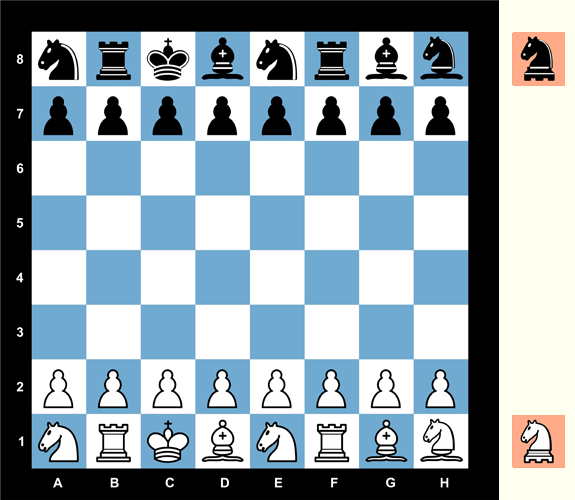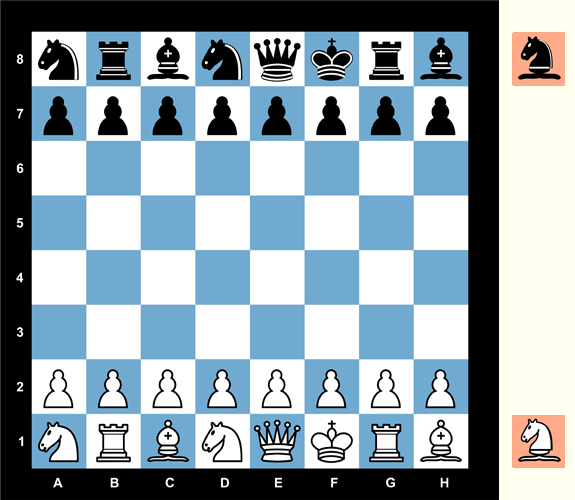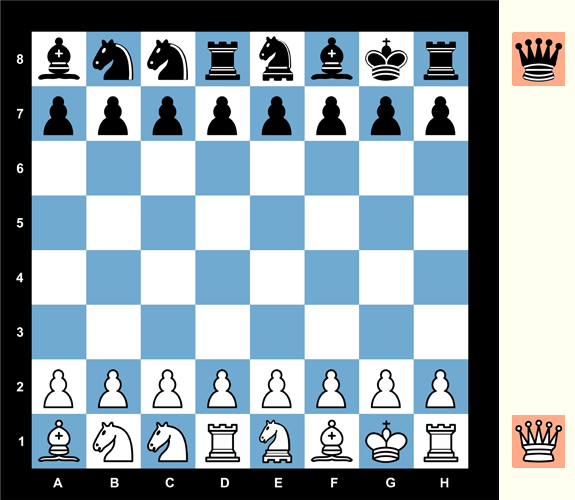VD Chess
In creating this game, I was inspired by three already existing and quite popular chess variants: Capablanca Chess, Fischer Random Chess, and S-Chess. The name of this variant, VD Chess, comes from Vicious Drop, but it also stands for my initials (Vujacic Davor) and ”vazdušni desant” (”airborne drop” in Serbian, Croatian and Bosnian).
VD Chess is a game of random chess with 5,760 possible starting positions and with two additional fairy pieces: the chancellor and the archbishop. The positions are always random, and for all the pieces except for the queen, the chancellor, and the archbishop, are identical to those in Fischer Random Chees. It means that the positions of pawns, knights, bishops, rooks, and the king are the same as in any of 960 possible positions in Fisher Random Chess. The remaining place can be taken randomly, by one of the three compound pieces: the queen, the chancellor, and the archbishop. These three compound pieces are treated equally, so instead of the queen, in what would be one on 960 positions from Fischer Random Chess we can sometimes also randomly get the chancellor or the archbishop.
Unlike in Fischer Random Chess and Capablanca Chess, and similar to S-Chess, one compound piece is ”an airborne drop” piece. That piece stays in reserve and can be dropped at any time on any available, free place on the chessboard as a separate move. Because there is only one but a vicious drop, and also, because its usage can create a lot of damage to the opponent, and can even lead to an immediate checkmate, it is of the biggest importance to drop this piece at the best moment and at the best place. This threat forces players to play extremely cautiously and to constantly analyze the vulnerability of their positions.
Setup
There are six possible starting sets of pieces and each of them has 960 possible starting positions. Just like in Fischer Random Chess, the bishops must be on the fields of different colors, and the king must be between two rooks.
1.) Q+C
960 starting positions with the queen, just like in Fischer Random Chess, and with the chancellor in reserve as the airborne drop piece.
2.) Q+A
960 starting positions with the queen, just like in Fischer Random Chess, and with the archbishop in reserve as the airborne drop piece.
3.) C+Q
960 starting positions with the chancellor instead of the queen, with all other pieces placed just like in Fischer Random Chess, and with the queen in reserve as the airborne drop piece.
4.) C+A
960 starting positions with the chancellor instead of the queen, with all other pieces placed just like in Fischer Random Chess, and with the archbishop in reserve as the airborne drop piece.
5.) A+Q
960 starting positions with the archbishop instead of the queen, with all other pieces placed just like in Fischer Random Chess, and with the queen in reserve as the airborne drop piece.
6.) A+C
960 starting positions with the chancellor instead of the queen, with all other pieces placed just like in Fischer Random Chess, and with the chancellor in reserve as the airborne drop piece.
This gives a total number of 5,760 possible starting positions.
There are two knights, two bishops, and two rooks and therefore it is reasonable to have only two compound pieces on the board at one moment. In one third of all the possible cases, there will be no queen on board except after promotion.
Here are three examples of starting positions:
In this case, we have a classical Fischer Random Chess position with the archbishop instead of the queen and with the chancellor as an airborne drop piece in reserve.

Here we have a standard Fischer Random Chess position with the queen and with the archbishop as an airborne drop piece in reserve.

Another example. This time, the random position is with the chancellor on the chessboard, and with the queen as an airborne drop piece in reserve.

Pieces
All standard pieces move just like in standard chess. There are two additional fairy pieces identical to those in Capablanca Chess.
- The archbishop (A) combines the powers of a bishop and a knight.
- The chancellor (C) combines the powers of a rook and a knight.
Rules
The promotion rules
There are differences in promotion rules in comparison with other variants.
1.) If you start with the queen on the chessboard and with the chancellor as an airborne drop piece in reserve, the pawn can promote only to the archbishop or to any other piece except for the queen and chancellor. Q+C+(A)
2.) If you start with the queen on the chessboard and with the archbishop as an airborne drop piece in reserve, the pawn can promote only to the chancellor or to any other piece except for the queen and chancellor. Q+A+(C)
3.) If you start with the chancellor on the chessboard and with the queen as an airborne drop piece in reserve, the pawn can promote only to the archbishop or to any other piece except for the queen and chancellor. C+Q+(A)
4.) If you start with the chancellor on the chessboard and with the archbishop as an airborne drop piece in reserve, the pawn can promote only to the queen or to any other piece except for the queen and chancellor. C+A+(Q)
5.) If you start with the archbishop on the chessboard and with the queen as an airborne drop piece in reserve, the pawn can promote only to the chancellor or to any other piece except for the queen and chancellor. A+Q+(C)
6.) If you start with the archbishop on the chessboard and with the chancellor as an airborne drop piece in reserve, the pawn can promote only to the queen or to any other piece except for the queen and chancellor. A+C+(Q)
These rules allow the theoretical possibility of the game with all three compound pieces at once, but only after the promotion.
Notes
The notation of dropped pieces is similar to one in Crazyhouse Chess.
For example
...
7. Qb3 C@d4 (the black chancellor was dropped at d4)
...
 This 'user submitted' page is a collaboration between the posting user and the Chess Variant Pages. Registered contributors to the Chess Variant Pages have the ability to post their own works, subject to review and editing by the Chess Variant Pages Editorial Staff.
This 'user submitted' page is a collaboration between the posting user and the Chess Variant Pages. Registered contributors to the Chess Variant Pages have the ability to post their own works, subject to review and editing by the Chess Variant Pages Editorial Staff.
By Davor Vujacic.
Last revised by Davor Vujacic.
Web page created: 2022-05-22. Web page last updated: 2022-07-19
